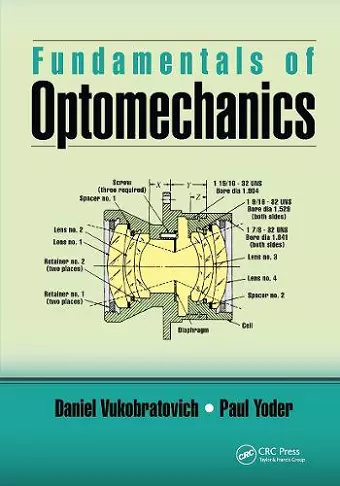Fundamentals of Optomechanics
Paul Yoder author Daniel Vukobratovich author
Format:Paperback
Publisher:Taylor & Francis Ltd
Published:2nd Oct '23
Currently unavailable, and unfortunately no date known when it will be back
This paperback is available in another edition too:
- Hardback£165.00(9781498770743)

When Galileo designed the tube of his first telescope, optomechanics was born. Concerned with the shape and position of surfaces in an optical system, optomechanics is a subfield of physics that is arguably as old as optics. However, while universities offer courses on the subject, there is a scarcity in textbook selections that skillfully and properly convey optomechanical fundamentals to aspiring engineers. Complemented by tutorial examples and exercises, this textbook rectifies this issue by providing instructors and departments with a better choice for transmitting to students the basic principles of optomechanics and allowing them to comfortably gain familiarity with the field’s content. Practicing optical engineers who engage in self-study and wish to enhance the extent of their knowledge will also find benefit from the vast experience of the authors. The book begins with a discussion of materials based on optomechanical figures of merit and features chapters on windows, prisms, and lenses. The authors also cover topics related to design parameter, mounting small mirrors, metal mirrors with a discussion of infrared applications, and kinematic design. Overall, Fundamentals of Optomechanics outfits students and practitioners with a stellar foundation for exploring the design and support of optical system surfaces under a wide variety of conditions.
- Provides the fundamentals of optomechanics
- Presents self-contained, student-friendly prose, written by top scientists in the field
- Discusses materials, windows, individual lenses and multiple lenses
- Includes design, mounting, and performance of mirrors
- Includes homework problems and a solutions manual for adopting professors
"This book addresses a pressing need for tools to teach optomechanical engineering at the University level. It also serves as a valuable reference work for practicing engineers. Organized into chapters on each of the engineer's tasks, from system-level assessments to component mounting, it flows logically through the mechanical design process.… it is a rich introduction to the art of optomechanical design."
—Alson E. Hatheway Incorporated, Pasadena, California, USA
"This book was written by the two most renowned specialists in optomechanics. The text is skillfully written to be understood easily while covering all the most important aspect of the optomechanical field. The material presented in the book is backed up with tutorial examples and exercises, thus distinguishing itself from other reference books in optomechanics intended to be used by practicing engineers. This textbook is an exceptional legacy of the fathers of optomechanics for the new generation of optomechanical engineers."
—Frédéric Lamontagne, INO, Quebec City, Canada
"It’s a terrific introduction into the field of optomechanical engineering that will allow novices and experienced engineers the prerequisite background and understanding of the highly integrated and complex engineering that is required to design and build a high precision optical system."
—Keith B. Doyle, MIT Lincoln Laboratory, Lexington, Massachusetts, United States
"Yoder and Vukobratovich do an exceptional job of creating content that is introductory at heart, but thorough enough to be useful and practical in application. It is unusual to get an engineering perspective woven into theory but they skillfully include both. Optomechanics is such a critical cross-discipline field for optics and it is unfortunately woefully underserved by the talent pipeline. An introductory text like this would be well-served to be on shelves of both optical and mechanical engineers in order to address the gap between the two disciplines."
—Katie Schwertz, Edmund Optics, Tucson, Arizona, USA
"The book would be ideal as a textbook for graduate students with some knowledge of both optics and mechanical engineering, or for practitioners in the field."
--Bogdan Hoanca, a professor of management information systems at the University of Alaska Anchorage, USA
ISBN: 9781032652382
Dimensions: unknown
Weight: 900g
462 pages